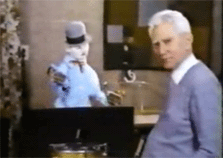
« PREVIOUS ENTRY
Grapefruit — the smell of youth
NEXT ENTRY »
Why Johnny can’t argue

Recently, I posted about research suggesting that video games could help patients recover from strokes — and that visualizing an action would help train you to perform it. In the ensuing comments, Bram pointed out that some jugglers use juggling-visualization software to mentally train. And that prompted longtime Collision Detection reader Brian Corcoran to email me with a flood of fascinating information about Claude Shannon’s juggling robots.
Who, pray tell, is Claude Shannon? Why, he’s only the inventor of modern information theory and the idea of using bits to solve complex boolean-logic problems — and, thus, he was a major inspiration for the modern computer. In his spare time, Shannon enjoyed juggling, and he even published a wonderful juggling theorem that set forth the relationship between the movement of the hands and the position of the balls. (By the way — there is no clear way to write that last sentence without the attendant double entendres. I tried.) Even cooler, Shannon built juggling robots! They’d drop balls onto the head of a drum, and catch them as they bounced up. Here’s a really excellent video of Shannon using one of the robots; a still from the movie is pictured above.
As it turns out, several people have followed in Shannon’s footsteps and built juggling robots. But according to an amazing 1995 Scientific American paper on the science of juggling, the robots have never quite emulated traditional human juggling — because they cannot master throw juggling, the art of tossing the balls in arcs through the air. The robots all work in other modes, as the article pointed out:
Although the bounce-juggling robots are fiendishly clever, a robot that can toss-juggle a three-ball cascade and actively correct mistakes has yet to be built. Some progress, however, has been achieved. Machines that can catch, bat and paddle balls into the air have been crafted. Engineers have also built robots that juggle in two dimensions. In the 1980s Marc D. Donner of the IBM Thomas J. Watson Research Center used a tilted, frictionless plane, similar to an air-hockey table. It was equipped with two throwing mechanisms moving on tracks along the lower edge of the table.
As Brian put it to me, one could think of juggling as “a sort of ‘physical’ Turing test for mechanical dexterity.”
(Thanks to Brian Corcoran for this one!)
I'm Clive Thompson, the author of Smarter Than You Think: How Technology is Changing Our Minds for the Better (Penguin Press). You can order the book now at Amazon, Barnes and Noble, Powells, Indiebound, or through your local bookstore! I'm also a contributing writer for the New York Times Magazine and a columnist for Wired magazine. Email is here or ping me via the antiquated form of AOL IM (pomeranian99).

ECHO
Erik Weissengruber
Vespaboy
Terri Senft
Tom Igoe
El Rey Del Art
Morgan Noel
Maura Johnston
Cori Eckert
Heather Gold
Andrew Hearst
Chris Allbritton
Bret Dawson
Michele Tepper
Sharyn November
Gail Jaitin
Barnaby Marshall
Frankly, I'd Rather Not
The Shifted Librarian
Ryan Bigge
Nick Denton
Howard Sherman's Nuggets
Serial Deviant
Ellen McDermott
Jeff Liu
Marc Kelsey
Chris Shieh
Iron Monkey
Diversions
Rob Toole
Donut Rock City
Ross Judson
Idle Words
J-Walk Blog
The Antic Muse
Tribblescape
Little Things
Jeff Heer
Abstract Dynamics
Snark Market
Plastic Bag
Sensory Impact
Incoming Signals
MemeFirst
MemoryCard
Majikthise
Ludonauts
Boing Boing
Slashdot
Atrios
Smart Mobs
Plastic
Ludology.org
The Feature
Gizmodo
game girl
Mindjack
Techdirt Wireless News
Corante Gaming blog
Corante Social Software blog
ECHO
SciTech Daily
Arts and Letters Daily
Textually.org
BlogPulse
Robots.net
Alan Reiter's Wireless Data Weblog
Brad DeLong
Viral Marketing Blog
Gameblogs
Slashdot Games